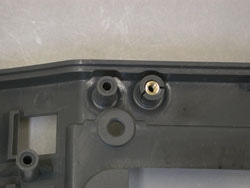October 22, 2012

Medical device failures can be disastrous, but they can be quickly resolved if a company takes immediate action to determine the cause of failure. Below is a list of five common causes of medical device failures and tips on how testing can pinpoint them. Expert analysis can determine the root cause of the failure, which will allow manufacturers to make adjustments where needed to prevent the problem from recurring.
1. Contamination. Contamination caused by a chemical attack or foreign substance can be tragic for a medical device. Luckily, however, chemical attacks are readily recognizable with various analytical techniques. Fourier transform infrared spectroscopy (FT-IR), for example, can examine fracture surfaces and identify residues or chemical contaminants on the surface. Scanning electron microscopy with energy dispersive x-ray analysis (SEM/EDS) also identifies failures. It can be used to examine fractures, determine whether a chemical attack has occurred, and identify elements present in the failure region.
2. Poor Molding. Medical devices often feature plastic components that are molded before final assembly. Unfortunately, molding defects can lead to device failure. In instances where device components have cracked, optical microscopy and SEM are excellent tools for evaluation of the fracture surface. Imaging by an experienced analyst can determine the crack initiation point and characterize melt flow and knit/weld lines. Furthermore, the melt flow and knit/weld lines will often coincide with the crack initiation point, suggesting that a mold defect is present.
3. Manufacturing/Assembly QC and Poor Product Design. A manufacturing defect can be more difficult to pinpoint than a molding defect. Thus, analytical expertise with multiple testing capabilities, including optical microscopy, SEM, FT-IR, thermal analysis, and tensile and compressive testing, may be necessary to identify the problem. Microscopy techniques can examine bond or weld areas, serving to evaluate the quality of assembled joints. FT-IR analysis, on the other hand, will confirm device materials and determine whether they are identical in good and failed samples. Differential scanning calorimetry (DSC) is also an excellent tool for failure analysis to determine crystallinity. Differences in crystallinity can result in shape changes or deformation as the part undergoes thermal aging and annealing. Depending on the failure, tensile and compression testing can be used to determine the force required to 'recreate' the failure. This information can be invaluable to the medical device manufacturer if an adjustment needs to be made to materials, dimensions, and material thermal properties.
4. Overstress. Stress overload or impact-related overstress most often results in part failure. Light microscopy and SEM are used to examine fracture surfaces and determine whether stress overload or impact is a probable cause of failure. When examining the fracture, the analyst may observe features that could be related to environmental stress cracking. Analysis using FTIR and/or separation techniques coupled with gas chromatography-mass spectrometry (GC-MS) may then be used to identify the stress crack agent.
5. Incorrect Material Selection. Material selection is critical to achieving the desired properties and capabilities of a finished medical device. But what seems like an optimal material for a given application may not necessarily be compatible with the medical device's service environment, or the resins may degrade during the molding process. If this happens, the medical device may fail in time, often during use. Thus, it is imperative to analyze resin materials of the failed part to help determine the cause of failure. Size exclusion chromatography (SEC) is the method of choice for determining the molecular weight of the resin materials compared with that of the failed part to conclude whether degradation occurred during the molding process. If degradation did occur during the molding process, a molecular weight change of 25% or more would be expected.
If an issue is not traced to degradation during molding, microscopic examination of the damaged part can identify whether a chemical attack has occurred. GC-MS, liquid chromatography-mass spectrometry (LC-MS), and high-performance liquid chromatography (HPLC) are invaluable techniques for analyzing additives extracted from failed components. The loss of stabilizers and antioxidants, after all, can shorten the service life of plastic parts.
About the Author(s)
You May Also Like


